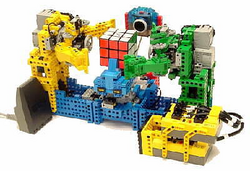
A few days ago I was explaining the art of prototyping to some formally-trained businesspeople, and when I mentioned that Lego made a good prototyping tool, their eyes glazed over. I knew I had lost them. “Surely you can’t spur innovation with a stupid plastic toy,” their inner investment banker asserted. “Innovation has to be expensive and exotic.”
Not only can you prototype anything (see my Steve McQueen riff below for that discussion), you can prototype with anything.
While the CubeSolver isn’t a prototype of anything, it is an existence proof of how seemingly simple (but not simplistic) tools can be used to prototype quite complex systems on the cheap. How cheap? Well, if I asked a crack team of engineers from HP Labs to make me a Rubik’s Cube solver, I’m sure they would create something brilliant, but I’m equally confident that, compared to this Lego wonder, their solution would be complex, expensive, and require many, many man hours to complete. Those of you who’ve ever worked at HP will note that I made no mention of multiple project cancellations and restarts, as well as a crew of waffling middle managers with bad shoes. But I digress.
If you’re prototyping things right, you’re cheating and stealing. Cheating, because you use things like Lego to better focus your energy on solving high-payoff issues instead of the mundane. Notice how the CubeSolver doesn’t use any custom parts – that would have been a waste when so many off the shelf Lego pieces are there for the taking. Stealing, because you’re borrowing forms and ideas from other designers. For example, there’s nothing innovative about the grabber mechanisms – they’re a pretty basic, tried-and-true design. No, all the design energy went into solving the “big idea” problems.
You can prototype with anything.


 Iridium. It was the ill-fated venture which placed 66 (out of a planned 77) communication satellites into orbit before finding out that the value proposition was fundamentally flawed. Millions of dollars were lost along the way. Could this fate have been avoided?
Iridium. It was the ill-fated venture which placed 66 (out of a planned 77) communication satellites into orbit before finding out that the value proposition was fundamentally flawed. Millions of dollars were lost along the way. Could this fate have been avoided?